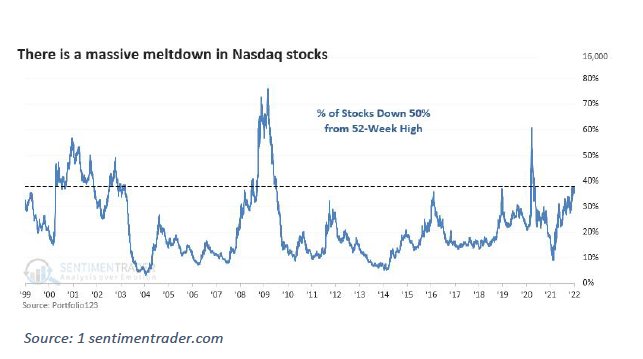Since early last year, we’ve been experiencing a stealth bear market in my opinion.
As the year progressed, more and more companies began turning down. Today, only the generals of the stock market remain in uptrends. The question is, if all the troops are in retreat, how long will it be before the generals also give up the fight?
You might be forgiven for thinking that this is a bad situation. It is just the reverse. In my view, there are currently companies and whole countries that are strongly out of favor and selling very cheaply. In my view, there are great bargains in this market.
Tech Selloff
In past investment letters, I have made my case that the majority of stocks in the Nasdaq have been in a bear market since July.
The 200-day moving average indicates the long-term trend of a stock’s price. Stocks that are trading under their 200-day moving average can be considered to be in a bear market, in my opinion.
Using this definition, as of late December, over 70% of stocks are in a bear market in the Nasdaq index. This measure gives us a broad idea of the level of weakness in the broad Nasdaq market
Sentimentrader.com gives us a more granular insight into the carnage that is actually taking place in the broad Nasdaq market.

According to Sentimentrader.com: “At no other point since at least 1999 have so many stocks been cut in half while the Nasdaq was so close to its peak.”
The chart below shows the percentage of stocks that have lost over 50% in the past year. We can see that close to 40% of stocks in the Nasdaq have had more than half their value wiped out.
Value Plays
A popular narrative going around right now is that the market is rotating from high flying growth companies to value-oriented companies. In the medium to long term, I generally agree with this idea. Certainly, as we saw above, the smaller growth companies have been hammered soundly in the past year.
However, in the short term, we can look at the carnage in the precious metals area, emerging markets and biotech to know that the rotation from growth to value does not happen in one step.
In past bear markets, we have seen the precious metals miners lead the market in a downturn. We are seeing this once again in my opinion.
Closely allied to precious metals producers and commodities are emerging markets. In the past year we have seen China, Turkey and, lately, Brazil retrace much of their gains from the March 2020 low.
These retracements in the precious metals and emerging markets as well as select other areas of the market are providing alert investors with terrific opportunities.
The companies in these sectors are selling at multi-year low price-to-earning multiples. And, compared to US companies, they are selling for a fraction of what the growth companies are selling for.
Volatile 2022
A combination of pandemic shutdowns, reopenings, and supply shortages have led to the US experiencing the highest inflation rate in 40 years. The Fed plans to combat inflation with the exuberance of a late arriving guest to a party. The exuberance is likely to be partially politically motivated.
The Biden administration has belatedly discovered that if you raise the cost of living for families across the country then the electorate will be sure to signal its displeasure.
In my view, the loose money policy that the Fed has engaged in throughout the pandemic has led to distortions in how capital is allocated. Once the punch bowl of loose money is removed, in my opinion investors in high flying companies will find that there is little that holds prices up, much less keeps them moving higher.
These high-flying sectors will lead the way lower for all commodities and commodity producers over the next 3 to 6 months. The energy complex, in particular, is nearing highs of the past 7 years.
Historically, energy is the last sector to go lower. That may be because once energy prices go high enough, energy begins to crowd out all other spending. As folk are discovering in Europe and elsewhere, energy is life. Almost no matter how high energy prices go, people will pay the price to the detriment of most other spending.
Bargain Hunting
As the year evolves, we will focus on buying those bargains that are most worthwhile at any one point in time. I expect the opportunities to change as the year progresses. This will allow us to diversify and to focus on those areas that promise the greatest potential returns.
As I noted above, today the opportunities are in the precious metals, emerging markets and select areas such as telecom and biotech. These sectors have given up 60% of their value from their highs in many cases. Should they return to their previous highs we can expect a doubling of their value or more.
My expectation is that we get similar opportunities in the energy and basic material spaces. A combination of ESG policies practically guarantee that little investment will be made in these areas over the coming years.
That will mean that existing firms will make super normal profits as supply is constrained. Add to that the fact that little investment has been made in these industries in the last 10 years.
In my opinion, I expect our investments in cash, bonds and hedges, where appropriate, will serve to buffer the volatility of the overall market. This will be important to preserve and, ideally grow, capital as we build positions in bargain areas of the market.
Photo Credit: Thomas via Flickr Creative Commons
Disclosure
This publication may contain forward-looking assessments, which are based upon a number of assumptions concerning future conditions that ultimately may prove to be inaccurate. Such forward-looking assessments are subject to risks and uncertainties and may be affected by various factors that may cause actual results to differ materially. This letter is provided as educational information only and is not intended to provide investment or other advice. This material is not to be construed as a recommendation or solicitation to buy or sell any security, financial product, instrument, or to participate in any particular trading strategy.
The Nasdaq Composite is a stock market index that includes almost all stocks listed on the Nasdaq stock exchange. Along with the Dow Jones Industrial Average and S&P 500, it is one of the three most-followed stock market indices in the United States. Investors can’t invest directly in indexes.


